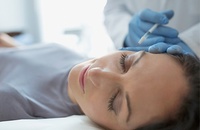Botox for Migraines: How the Injectable Stops Severe Headaches
If you've ever had migraines, you know how debilitating they can be. Sure, there's Excedrin Migraine, peppermint essential oil, cold compresses, dark rooms, and even prescription medicines designed to bring relief. But sometimes those don't work. That's when you may want to consider Botox for migraines.
The FDA greenlit the use of Botox for migraine headaches in 2010 after studies showed that patients who received Botox injections for crow's-feet and frown lines reported experiencing fewer headaches. But make no mistake—Botox is not a catch-all remedy for any type of cranial discomfort. Read on for more info about how the treatment works, and who it works for. Spoiler: It’s not for all migraine-sufferers.
- How does Botox prevent migraines?
- Will it work for me?
- Where is the Botox injected?
- How many injections will I need?
- How often do I need Botox injections?
- How can I tell if it’s working?
- How much does it cost?
- Will it also smooth my wrinkles?
- Who shouldn’t get Botox for migraines?
- What are the side effects?
First things first, how do Botox injections for migraines work?
Clinical trials have shown that Botox can prevent an average of 8–9 headache days and migraine days or probable migraine days a month.
How it works EXACTLY is unclear. Initially, it was thought that Botox's ability to reduce muscle spasms might be the answer, but that theory has since been debunked. Some scientists now speculate the injections may block the release of certain neurotransmitters to nervous systems. But that hasn't been proven, so it's anybody's guess at this point. Although that may seem surprising, it shouldn't be, considering doctors still don't know the causes of some headaches.
You said this wasn't for all migraine-sufferers. Is it for me?
Right now, Botox is only approved for adults who experience chronic migraine. According to Botox’s manufacturer, chronic migraine is defined as 15 or more headache days a month, with at least 8 of those headaches being migraines lasting four hours or more. Researchers estimate this is about 3.3 million adults in the United States.
So where is Botox injected for migraine headaches?
The Botox for migraines injection sites include seven zones in the head, neck, and shoulders.
Exactly how many times will they stick me?
Let's not sugarcoat this: each session involves 31 total injections in the head, neck, and shoulders. But it's not as bad as it sounds. Botox's manufacturer, Allergan, recommends doctors use a very fine, 0.5-inch-long needle. That’s shorter than the length of a dime. And that needle is inserted into shallow muscles. Plus, the whole shebang takes about 15 minutes.
How often do you have to get it done?
You only have to get injected every 12 weeks—i.e., when the Botox starts to wear off.
Every 12 weeks? I have headaches way more often than that.
Don’t panic. Using Botox for migraines was approved by the FDA as a preventive treatment. Most people's symptoms improve after the first month, but it's recommended that patients undergo two treatment cycles, which takes 24 weeks, to see full results—the elimination of up to nine headache days a month.
Well, if they don't know how Botox for migraines works, how can I tell if it's working?
Good question. Allergan recommends keeping a headache diary tracking the days you have headaches, how long the pain lasts, and the headaches' potential triggers. You can also record other medications you've tried and document whether or not they've worked for you. Ideally, over time, you'll see fewer and fewer headache days on your calendar.
How much does Botox for migraines cost?
Typically, insurance will cover the cost of this migraine treatment, though you may have a copay or have to meet your deductible.
Will the Botox smooth my wrinkles, too?
Yes. Because of where it's injected, you should have a smoother forehead. But don't think you can just say you have migraines to get your insurance to cover your Botox wrinkle injections. You typically have to prove that you've exhausted all other migraine-treatment options before you can get insurance to cover Botox.
Is there anyone who shouldn’t get this treatment?
Again, using Botox for migraines is only approved for people who suffer from at least 15 headache days a month.
Do not get Botox for migraines if you:
- Suffer from 14 or fewer headache days a month (also known as episodic migraine)
- Are allergic to any of the ingredients in Botox or to any other botulinum toxin product (Dysport, Xeomin, etc.)
- Have an infection at the planned injection site
Inform your doctor if you:
- Have a disease that affects your muscles and nerves (such as ALS or Lou Gehrig's disease, myasthenia gravis, or Lambert-Eaton syndrome)
- Have had injections of any other botulinum toxin product in the past
- Have bleeding problems
- Have drooping eyelids
- Have plans to have surgery
- Have had surgery on your face
- Are pregnant, plan to become pregnant, or are breastfeeding. It is not known if Botox can harm an unborn baby or pass into breast milk.
What are the Botox for migraines side effects?
Possible side effects include:
- Life-threatening complications, including problems swallowing, speaking, or breathing
- Allergic reactions such as rashes and welts
- Discomfort or pain at the injection site
- Spread of toxin effect: Areas away from the injection site may be affected by such problems as muscle weakness, double or blurred vision, drooping eyelids, and loss of bladder control. However:
- This is a general side effect associated with all Botox injections.
- There has not been a confirmed serious case of spread of toxin effect away from the injection site when Botox has been used at the recommended dose to treat chronic migraine.
Read all of the safety considerations for Botox for migraines here.
Source
The information contained in this article is from Botox's manufacturer, Allergan. Learn more here.
RELATED READS
 What Is Botox: The Complete Guide
What Is Botox: The Complete GuideThis guide will take you beyond the basics of Botox injections, step by step.
 Botox Forehead & Face Guide: What to Know in Simple Illustrations
Botox Forehead & Face Guide: What to Know in Simple IllustrationsIncluding where you'll get your injections and how many units you need to treat frown lines, forehead lines, and crow's-feet
 What Is Dysport and How Does It Work?
What Is Dysport and How Does It Work? Dysport can help improve the appearance of lines by paralyzing the muscles that form them. Read on to learn all about the wrinkle-fighter.
 What Is Xeomin? A Guide to the Botox Alternative
What Is Xeomin? A Guide to the Botox AlternativeLearn all about Xeomin, another injectable that can banish wrinkles.






